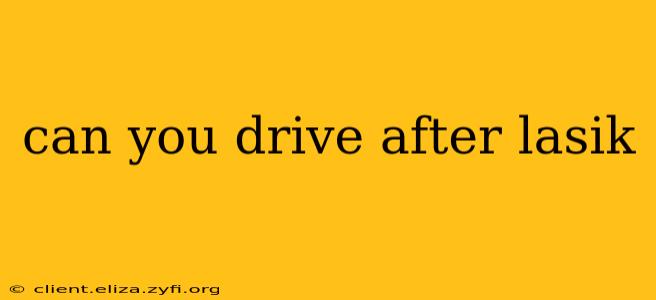LASIK surgery is a transformative procedure that can correct refractive errors and eliminate the need for glasses or contact lenses. However, a crucial question many patients have is: can you drive after LASIK? The answer isn't a simple yes or no, and depends on several factors. This comprehensive guide will explore the complexities surrounding driving post-LASIK, addressing common concerns and providing clear guidelines.
How Soon Can I Drive After LASIK?
This is arguably the most frequently asked question. The short answer is: it's not advisable to drive immediately after LASIK. While some individuals may experience minimal visual disturbances, most patients experience some degree of blurry vision, light sensitivity, or dry eyes immediately following surgery. These effects can significantly impair driving ability and put you and others at risk.
Your ophthalmologist will provide specific instructions tailored to your individual recovery. However, a common recommendation is to arrange for a designated driver to take you home after the procedure. Driving should be avoided until your vision has stabilized and your doctor explicitly clears you to do so. This typically occurs within 24 hours to a few days after the surgery, but it varies considerably from patient to patient.
What Are the Potential Risks of Driving Too Soon After LASIK?
Driving while experiencing blurry vision, glare, or other visual disturbances after LASIK is inherently dangerous. Here are some key risks:
- Reduced reaction time: Impaired vision can slow your reaction time to unexpected events on the road, increasing the likelihood of accidents.
- Difficulty judging distances: Accurate distance perception is critical for safe driving, and this can be affected immediately following LASIK.
- Increased sensitivity to light: Glare and sensitivity to bright sunlight can make driving particularly challenging and dangerous, especially at night.
- Eye discomfort: Discomfort or pain in your eyes can distract you from driving safely.
What Vision Improvements Should I Expect Before Driving?
Before you consider driving after LASIK, you should experience:
- Stable vision: Your vision should be consistently clear and stable, without significant fluctuations.
- Reduced glare and halos: Glare and halos around lights, common in the early stages of recovery, should be minimized or absent.
- Comfortable vision: You should feel comfortable driving without significant eye strain or discomfort.
- Doctor's approval: The most important indicator is your ophthalmologist's clearance. They will assess your visual acuity and overall recovery before giving you the go-ahead to drive.
How Long Does It Take for Vision to Fully Recover After LASIK?
Full visual recovery after LASIK can take anywhere from a few days to several weeks. While you might experience significant improvement within the first 24-48 hours, your vision will continue to refine over time. Factors influencing recovery speed include individual healing responses, the type of LASIK procedure performed, and any pre-existing eye conditions. During this period, patients should avoid strenuous activities and follow their doctor's post-operative instructions diligently.
What if I Have Other Medical Conditions?
Patients with certain underlying medical conditions might have a slightly slower recovery time or experience different visual effects after LASIK. It's crucial to discuss any pre-existing health conditions with your ophthalmologist before surgery to ensure they understand your individual circumstances and can provide tailored advice on driving post-operation. They can better assess the risks and advise you accordingly.
Should I Wear Sunglasses After LASIK While Driving?
Yes, wearing sunglasses after LASIK, especially during the initial recovery period, is highly recommended. Sunglasses help reduce glare and protect your eyes from bright sunlight, both of which can be problematic in the days immediately following surgery. Consider wearing sunglasses even on cloudy days until your vision fully stabilizes.
In conclusion, while LASIK offers incredible benefits, patience and caution are paramount during the recovery phase. Prioritize your safety and the safety of others by following your doctor's instructions carefully and avoiding driving until your vision is fully restored and you receive explicit clearance from your ophthalmologist. This responsible approach ensures a safe and successful recovery.
